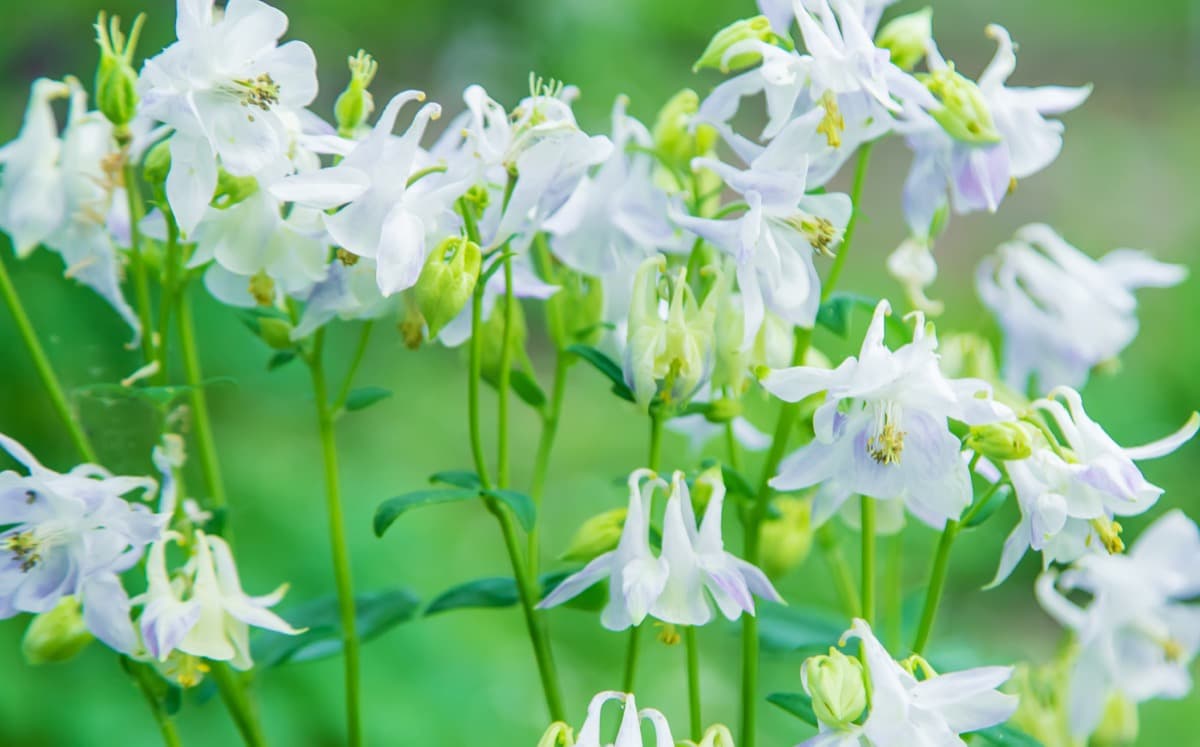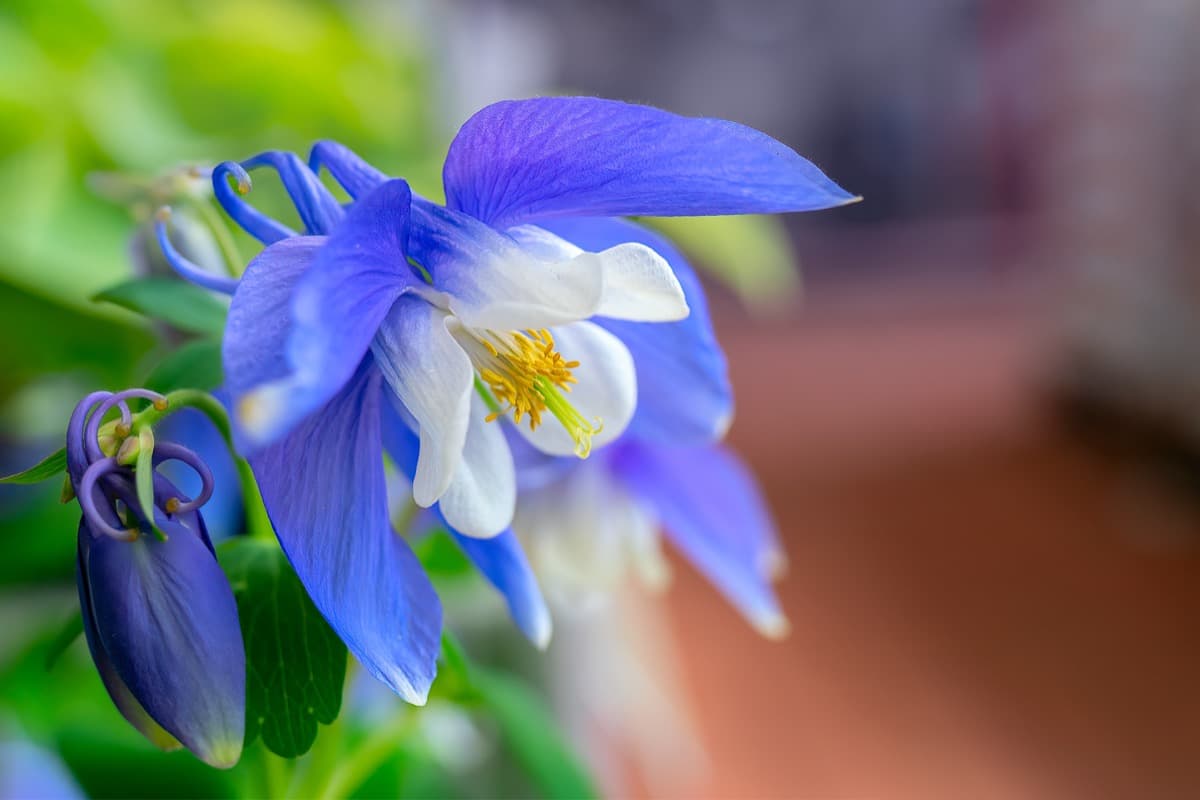Columbine flowers are popular with gardeners due to their unique and delicate beauty. They come in various colors, making them the best choice for adding color to your garden. If you are new to gardening and want to plant, grow, and care for columbine flowers, this guide will help you get started.

How to Grow and Care for Columbine Flowers
How to Plant Columbine Flowers From Seeds in Your Garden
- Columbine flowers prefer well-draining soil. Choose a spot in your garden yard that receives sunlight 4-6 hours daily.
- Before planting, prepare the soil by removing any weeds, rocks, or debris. Mix in some vermicompost or organic matter to improve the soil’s fertility and drainage.
- Sow the columbine seeds in the prepared soil at a depth of 1/8 inch. Space the seeds about 12 inches apart.
- After planting, water the seeds gently to moisten the soil. Keep the soil moist but not waterlogged.
- Columbines take about 14 to 21 days to germinate. Once the seedlings appear, thin them out to about 18 inches apart.
- Columbine flowers are relatively easy to care for. Water them regularly, especially during dry spells. Mulch around the plant’s base to help retain moisture and suppress weeds. Deadhead spent flowers to encourage more blooms.
Best Soil and Fertilizer for Healthy Columbine Flower Growth
Soil
Columbine flowers prefer well-draining soil with a slightly acidic pH between 5.0 and 7.0. The soil should also be rich in organic matter, like compost or aged manure, to provide the nutrients for healthy growth. It’s important to avoid heavy clay soils, which can cause waterlogging and negatively impact plant growth.
Fertilizer
Columbine flowers benefit from regular fertilization, especially during the growing season. A balanced fertilizer with N-P-K ratio of 10-10-10 or 12-12-12 is most suitable. You can also use a slow-release fertilizer to provide a steady supply of nutrients over time. It’s important not to over-fertilize columbine flowers, as this can lead to more foliage growth at the expense of flower production.
Watering Schedule for Columbine Flowers: What You Need to Know
- Columbine flowers require regular watering, especially during the hot summer months. Watering them at least once a week is recommended, providing enough water to saturate the soil to a depth of 6 inches. If the soil is dry, it is time to water the plants.
- It is important to note that over-watering can harm columbine flowers. These plants prefer well-draining soil, and excessive watering can lead to root rot. It is best to water columbine flowers deeply but infrequently to avoid this.
- In addition to regular watering, keep an eye on the weather. During periods of heavy rain, it may be necessary to adjust the watering schedule to avoid waterlogging the soil.
- When watering columbine flowers, it is best to avoid getting the leaves wet. Wet leaves can lead to fungal diseases, impacting the plant’s health. Instead, direct the water toward the base of the plant.
- Finally, columbine flowers require less water during the winter months when they are dormant. It is recommended to reduce watering to once every two weeks.
Step-by-step Guide to Growing Columbine Flowers Indoors
Planting Columbine Flowers
- Choose a location that receives partial shade to full sun.
- Ensure the soil is well-draining and fertile.
- Plant the columbine seeds in the spring or fall.
- Sow the seeds directly into the soil bed or start them indoors, and once they are established, transplant them outdoors.
- Space the plants about 12-18 inches apart to allow adequate room for growth.
Growing Columbine Flowers
- Water columbine flowers regularly, especially during dry spells.
- Apply a slow-release fertilizer to the soil in the spring.
- Deadhead the flowers as they begin to wilt to encourage new growth.
- Columbine flowers can reach up to 2 feet, so consider staking the plant to prevent it from falling over.
In case you missed it: From pH Levels to Composting: How to Prepare the Best Soil for Your Flower Garden

Caring for Columbine Flowers
- Check the plants regularly for pests such as aphids and spider mites, and treat them accordingly.
- Prune any dead or damaged leaves or stems to keep the plant looking healthy.
- Divide the plants every 2-3 years to prevent overcrowding and promote healthy growth.
- In the fall, cut back the stems to about 2 inches above the ground to prepare the plant for winter.
Protecting Columbine Flowers From Pests and Diseases
- Keep your columbine flowers healthy: Healthy ones are less likely to be attacked by pests or diseases. Plant your flowers in well-draining soil and provide adequate water and sunlight.
- Monitor for pests: Watch for common pests such as aphids, spider mites, and caterpillars. If you notice any pests, remove them by hand or use an insecticidal soap spray. Instead, consider using natural methods, such as introducing beneficial insects like ladybugs or neem oil.
- Prevent fungal diseases: Fungal diseases can be problematic for columbine flowers. To prevent them, avoid overhead watering and make sure your plants have good air circulation. If you notice signs of fungal disease, remove any infected leaves or flowers and apply a fungicide.
- Practice good garden hygiene: Keeping your garden clean can stop pests and diseases from spreading. Remove any dead or decaying plant material and dispose of it properly.
Sunlight Requirements for Successful Columbine Flower Cultivation
Columbine flowers typically require moderate to full sunlight to grow and bloom successfully. They need at least 4-6 hours of direct sunlight daily. However, it is important to note that Columbines can also tolerate some shade, particularly during the hottest parts of the day.
When choosing a location for your Columbine plants, look for an area that receives morning sun and afternoon shade. This will give them the ideal amount of light to grow and thrive. If you live in a particularly hot or sunny climate, consider planting your columbines in an area with spotty shade or filtered sunlight.
Ensuring your Columbine plants receive enough sunlight throughout the growing season is also important. If planted in an area that receives too much shade, they may not produce as many blooms, or their growth may be stunted. Conversely, if planted in an area that receives too much direct sunlight, they may become stressed and wilt.
Pruning and Deadheading Columbine Flowers: a Beginner’s Guide
Pruning Columbine Flowers
Early spring is the best time to prune columbine flowers, just as new growth emerges. Follow these steps to prune columbine flowers properly:
- Use clean, sharp garden shears to make your cuts. This will prevent damage to the plant.
- Identify any dead, damaged, or diseased stems. These should be removed first.
- Cut back any stems that are too tall or leggy. Aim to remove about one-third of the stem’s length.
- Cut the remaining stems to just above a set of leaves or buds. This encourages the plant to produce new growth.
Deadheading Columbine Flowers
- Wait until the blooms have faded and begun to wilt.
- Use clean, sharp garden shears to make your cuts. This will prevent damage to the plant.
- Cut the stem back to just above a set of leaves or buds. This encourages the plant to produce new growth and blooms.
- Continue deadheading throughout the blooming period to encourage the plant to produce more flowers.
Overwintering Columbine Flowers: Preparing Them for Colder Months
- Mulch around the base of the columbine plants with a layer of straw or leaves. This will help to insulate the roots and keep them warm.
- Cut back the foliage of the columbine plants to about 2-3 inches above the ground once they have gone dormant for the winter.
- Water the columbine plants deeply before the ground freezes to help them stay hydrated throughout the winter.
- Cover the columbine plants with a burlap or frost cloth to protect them from harsh winds and freezing temperatures. Be sure to remove the coverings during the day to allow the plants to receive sunlight.
Companion Plants for Columbine Flowers to Enhance Their Beauty
- Salvia: Salvia is a great companion plant for columbine flowers. It has beautiful blue or purple flowers that contrast well with the soft colors of columbine flowers.
- Coral Bells: Coral bells are another great companion plant for columbine flowers. They have beautiful foliage in various colors, including green, purple, and bronze.
- Lamb’s Ear: Lamb’s ear is another excellent companion plant for columbine flowers. Its silver-green leaves make a stunning contrast against the bright colors of the columbine flowers.
In case you missed it: Discover the Beauty of Nature with These Top 20 Purple Flower Types

Conclusion
With their unique beauty and easy maintenance, columbines are a great addition to any garden. Even beginners can plant, grow, and care for columbine flowers following these instructions.
- Feed Your Flock for Less: Top 10 Tips to Save on Chicken Feed
- Ultimate Guide to Ossabaw Island Hog: Breeding, Raising, Diet, and Care
- Hatching Answers: The Top 10 Reasons Your Chickens Aren’t Laying Eggs
- Eggs and Economics: Breaking Down the Cost of Raising Backyard Chickens
- Defend Your Greens: Proven Methods to Keep Iguanas Out of Your Garden
- Ultimate Guide to Cinnamon Queen Chicken: A Comprehensive Guide for Beginners
- Ultimate Guide to California Tan Chicken: Breeding, Raising, Diet, Egg-Production and Care
- Ultimate Guide to Marsh Daisy Chicken: Breeding, Raising, Diet, and Care
- 10 Types of Chicken Farming Businesses You Can Start for Profits